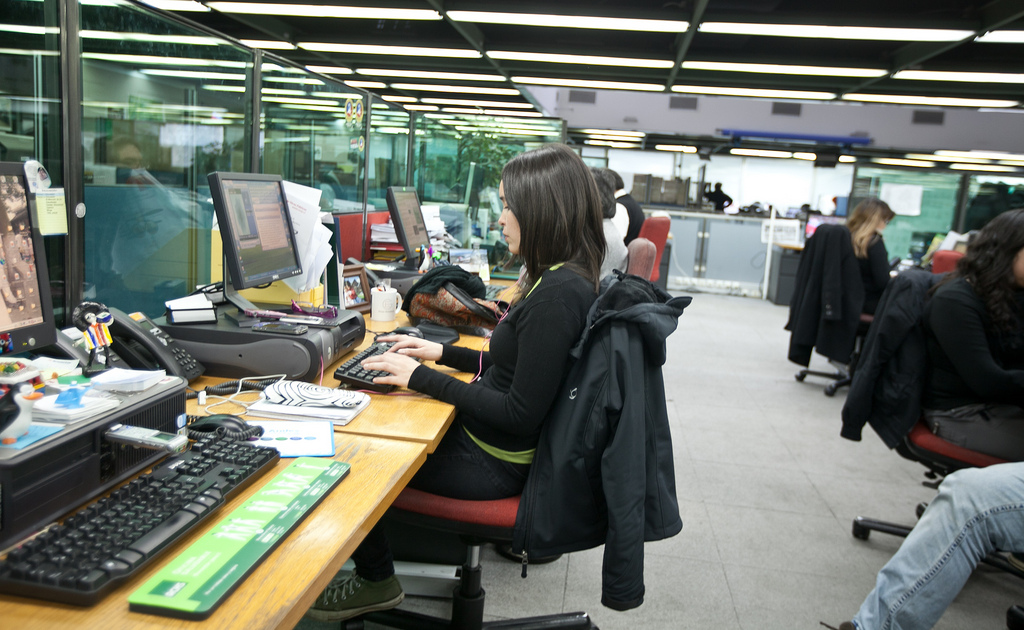We tend to use pretty concrete language in journalism, so it’s not surprising that the place where we work isn’t just an office, it’s a newsroom. Earlier this week, I wrote about The Middletown Press’ move away from a physical newsroom to a virtual one.
As part of that story, I asked journalists about their own experiences working remotely. What worked? What did they miss?
Chris Morris, an illustrator with The Cleveland Plain Dealer, has found working from home gives him more time focus.
“I am available to meet whenever I am needed — I don’t reject face-to-face time. Happy to see my colleagues. I keep to a schedule and am disciplined to do this,” he said in a Twitter direct message. “But as Jason Fried pointed out, I just don’t need the distractions that come with the day to day office space.”
See also: Dripping coffee, primal screams and other newsroom sounds that might disappear
Monica Guzman, a 2016 Nieman Fellow who previously served on Poynter’s National Advisory Board, has worked remotely since 2011. She misses getting to check in with people casually and last-minute lunch trips, but “I don’t miss the cultural obstacles to getting things done or spending lots of energy avoiding entanglements that distract you.”
Like me, Poynter’s Butch Ward often works remotely. Many reporters, especially foreign correspondents, have worked this way for years, he said. The question for Ward is this — How much human contact is needed to do your job? Editors and managers, for instance, may need to physically be together to better collaborate.
“I think it can be good for a whole variety of people,” he said in a phone interview. “I think it has more to do with the execution than whether it’s absolutely wrong for any one job.”
The key, when you are working remotely, is the same thing that is essential in a newsroom — you have to communicate.
“It’s even more important, because what they don’t hear from you, they might not hear from anybody,” Ward said.
See also: This newsroom-themed hotel is a dream or a nightmare, depending on how much you like work
Guzman agreed.
“It helps not to under-communicate,” she said in an email. “When things get wacky it’s when you’re not all on the same page. Emails are not always the best way to clear things up — knowing when to pick up the phone or schedule a lunch or a more freewheeling conversation (if you’re never in the same place as your team/editor) is a good thing.”
See people face-to-face, Ward agreed. And don’t just rely on text or messaging.
“You gotta be on the phone sometimes, not all the time, so you can hear a voice and there’s less chance of misunderstanding a communication.”
Timothy Cotter, managing editor of The (New London, Connecticut) Day, emailed me with a piece he wrote but never published about the value of newsrooms. It includes this:
In The Day newsroom, reporters generally sit with those who have similar beats. Business reporters in one group, feature writers in another, sports staff down the hall. They sit together, work together, sometimes go out for coffee or beer together.
A young reporter can ask a veteran whom to call for the dreaded weather story, but also where to get a cheap beer (Dutch Tavern) or the best lobster roll (Capt. Scott’s, where it’s served either warm or cold). Can this type of interaction happen via email, conference calls or Skype?
Young reporters at The Day, in either their first or second jobs, improve greatly in the first 12-18 months. Some of that, I’d like to think, is through working with editors, but I believe that much of it comes from watching and listening to other reporters and from bouncing a troublesome lead off the person at the next desk.
And once you get over the fact that it seemed ironic, or at least odd, that the CEO of a web-based company was ordering people out of home offices and back into corporate offices, wasn’t Yahoo’s Marissa Mayer saying the same thing: working with other people makes us better at our jobs, both as individuals and as a group.
‘Some of the best decisions and insights come from hallway and cafeteria discussions, meeting new people, and impromptu team meetings,’ she said in her memo to employees.
On a good day, that’s what happens in newsrooms across the globe. And that’s why they haven’t gone the way of hot type.
Below, I pulled together a Storify of tweets and Facebook posts from people who have made working remotely work and from people who’d miss the newsroom too much.
See also: Yes, journalists at W. Va. paper also work at a hotel. But they get free coffee







